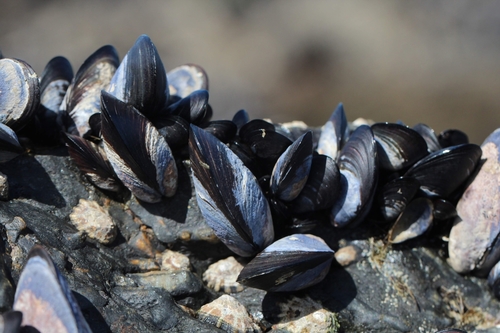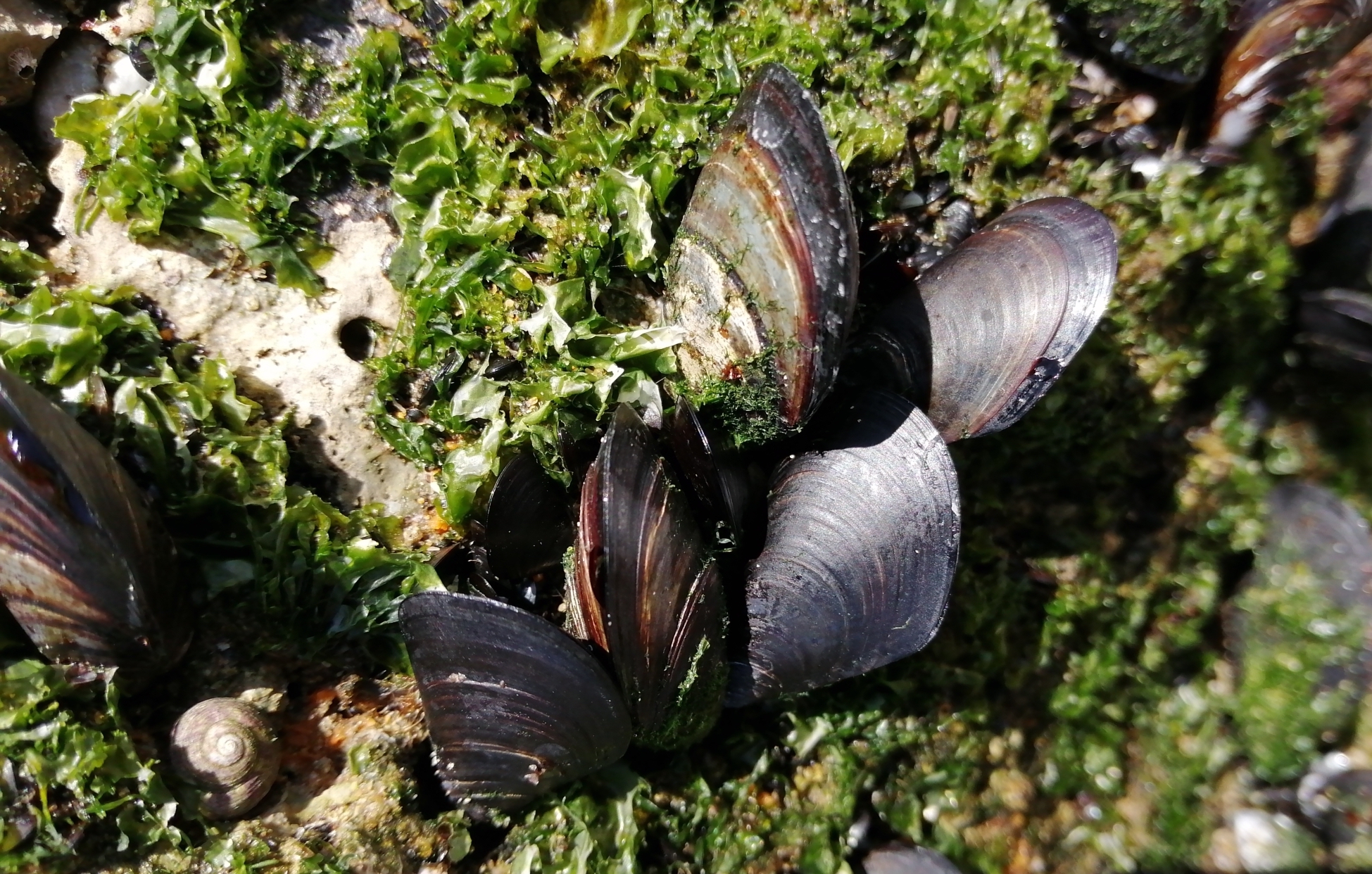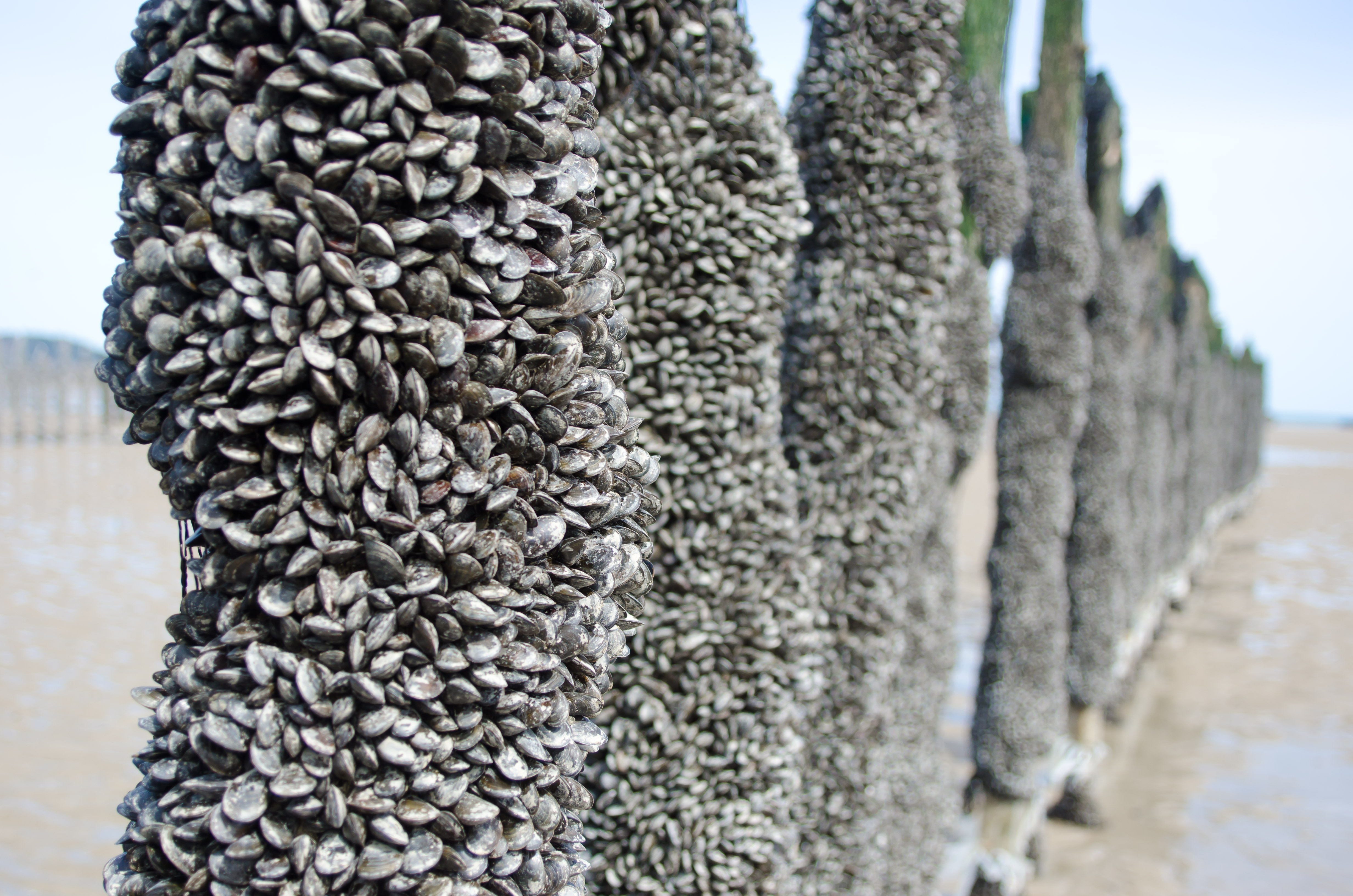Mytilus galloprovincialis
North Coast (Oregon Border to Point Arena)
North Central Coast (South of Point Arena to Half Moon Bay)
Central Coast (South of Half Moon Bay to Point Conception)
Santa Barbara (Point Conception to Point Dume)
South Coast (Point Dume to Mexico border)
Farmed
Shellfish

The Science

Taxonomic description
- Also known as the black mussel because the shell can be dark blue or brown to an almost black color, relatively smooth.
- The two shells are equal, each with a rounded and a slightly bent edge.
- Grows up to 15 cm (6”) but is typically found to grow between 5-8 cm (2-3”). [2]
Distribution
- Native to the Mediterranean coastline, but is found around the world due to unintentional transport of the larvae and adults in ballast water and hull fouling communities of ships traveling overseas for shipping and trade; and intentional introductions for aquaculture. [2]
Life history
- Fast growing with high reproductive output.
- Can attain 7 cm within its first year at favorable sites. [2]
- Can reproduce multiple times per year and reach sexual maturity in 1-2 years.
- Reproduces through broadcast spawning, or releasing gametes into the water column. [1]
- Fertilized eggs develop into free-swimming larvae, which then attach to rocks.
Habitat
- Found mostly on temperate sheltered and exposed rocky shores; attaches to rocks using byssal threads.
- Extremely tolerant to environmental changes. [2]
- Mostly found in the intertidal zone where there are intermediate levels of wave exposure. [2]
- Able to hybridize with sister taxa, including M. trossulus (bay mussel) which is native in California.
- Feeds by filtering particles through gills.
- Main predators include sea stars & gulls.
The Fishery

Seasonal availability
- Available year-round.
Regulatory and managing authority
- Marine aquaculture in California is overseen by a number of federal and state agencies the specifics of which depend upon the location of the facility (land, state waters, federal waters) and type(s) of species grown. These agencies include but are not limited to NOAA, for oversight in federal waters, California State Lands Commission, for oversight in coastal waters and land, and California Department of Fish and Wildlife for registration. [11]
- A State Aquaculture Coordinator provides guidance on permits, registrations, and consultations, which are required for all commercial aquaculture. [11]
- On public and private lands, aquaculture must follow regulations regarding water discharge, which involves multiple management agencies. [11]
- The California Department of Public Health is involved in growing, harvesting, and selling molluscan shellfish and seaweeds. [11]
- The Permit Guide to Aquaculture in California is available at https://permits.aquaculturematters.ca.gov/Permit-Guide#454735-california.... [11]
Gear type
- Grown off bottom in the water column on vertical lines of rope supported by buoys. When it is time to harvest, ropes are lifted using booms over a boat deck and the mussel is collected. [4]
- No fertilizers, chemicals or antibiotics added-food is naturally occurring phytoplankton.
Status of the fishery
- Most U.S. farms collect mussel larvae from wild populations and transfer them to the farm for grow-out to adults. [6] This has little effect on wild populations due to the mussel’s high reproductive rates.
- Recent technology has allowed culturing of larvae on the farm. [3]
Potential ecosystem impacts
- Aquaculture reduces the pressure on local natural populations and limits the need for imported seafood.
- The presence of mussel and racks create habitat for marine plants and animals, and improve water quality by the mussel filtering algae and particulates. Some benthic disturbance results from shading and organic accumulations beneath racks. [5]
- As it is tolerant of a wide-range of conditions, it can survive in many non-native coastal ecosystems if released as larvae or adults. [5,8]
The Seafood
Edible portions
- Entire contents of the shell.
Culinary uses
- Best fresh, but may be frozen.
- It is generally cooked whole, for example, steamed until the shell opens.
- Add mussel to a pan containing ingredients like olive oil, garlic, lemon, wine, and red peppers, over medium heat. Once open and cooked, it’s ready to eat!
- For recipe ideas using Mediterranean mussels, visit Yummly. [10]
Description of meat 
- This species is much meatier than most other mussels.
- Has a delicate flavor with a rich, buttery texture.
Nutritional information
- Nutritional information for 100g of raw mussel can be found on the table to the right. [7,9]
Toxicity report
- Farmed mussels are controlled and monitored for safety with no reported contaminants.
- Collecting mussels from local bays is not recommended; biotoxin levels are often unmonitored and depend on quickly fluctuating water quality and algal blooms of the bay. Many of these toxins cannot be cleared with freezing or cooking. [9]
Seasonal availability
- Available farm fresh in San Diego year-round. [8]
References
[1] Van Erkom Schurink, C. & Griffiths, C.L. 1991. A comparison of reproductive cycles and reproductive output in four southern African mussel species. Marine Ecology Progress Series 76: 123–134. https://www.int-res.com/articles/meps/76/m076p123.pdf
[2] GISD. 2012. Global Invasive Species Database - Mytilus galloprovincialis -Available from http://www.issg.org/database/species/ecology.asp?si=102&fr=1&sts=sss&lan...
[3] FishWatch. 2013. Blue mussel. NOAA FishWatch U.S. Seafood Facts. https://www.fishwatch.gov/profiles/blue-mussel-farmed.
[4] Carlsbad Aquafarm. Prod. Brian Robles and Cindy Kendrick. Green-Scene, 2013. YouTube. https://www.youtube.com/watch?v=Yzy2y5S-A_o
[5] Shinen JS, Morgan SG. 2009. Mechanisms of invasion resistance: competition among intertidal mussels promotes establishment of invasive species and displacement of native species. Mar Ecol Prog Ser 383: 187-197. https://doi.org/10.3354/meps07982
[6] European Commission. 2013. Fisheries. http://ec.europa.eu/fisheries/marine_species/farmed_fish_and_shellfish/m...
[7] SELF Nutrition Data. 2013. Mollusks, mussel, blue, cooked, moist heat. https://nutritiondata.self.com/facts/finfish-and-shellfish-products/4187/2.
[8] Richards, John B., and George A. Trevelyan. "Culture of Mussels." Trans. California's Living Marine Resources: A Status Report. California Department of Fish and Game, 2001. Web. 10 Aug. 2013. https://nrm.dfg.ca.gov/FileHandler.ashx?DocumentID=34257&inline.
[9] "Mediterranean Mussels." FishChoice.com. FishChoice Inc., n.d. Web. 10 Aug 2013. www.fishchoice.com/buying-guide/mediterranean-mussels.
[10] Yummly. n.d. Mediterranean Mussels Recipes. Web. www.yummly.com/recipes/mediterranean-mussels. Accessed 15 January 2021.
[11] Permit Guide to Aquaculture in California. N.d. Permit Guide to Aquaculture in California. Web. https://permits.aquaculturematters.ca.gov/Permit-Guide#454735-california.... Accessed 21 August 2020.
[12] Lopes, L. iNaturalist. 2019. Digital image. Web. https://www.inaturalist.org/photos/100574100. Accessed 18 February 2021.
[13] guif. iNaturalist. 2019. Digital image. Web. https://www.inaturalist.org/photos/45612337. Accessed 18 February 2021.
[14] hey tiffany!. flickr. 2014. mussel farm. Digital image. Web. https://flickr.com/photos/_tiffany/13987537414. Accessed 18 February 2021.
[15] James. flickr. 2013. Mussels with Garlic and Ginger. Digital iamge. Web. https://flickr.com/photos/40726522@N02/8663615019. Accessed 18 February 2021.
